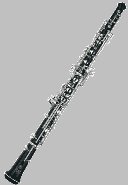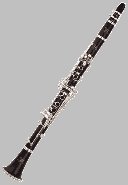This Equals That?
Job Status
No job yet. Hmm... actually I'm considering taking some courses instead to upgrade myself. Well, let's see whichever comes first.
Are This and That the Same?
Well, I come up with this topic because there are some things that to some people looks alike. Well, let me start off with Oboe and Clarinet, which most of the people will get mistaken of with each other.
Oboe and Clarinet
Ok, whenever I visit Yamaha Music Shop to browse through the scores, I will always see people mistaken Oboe as an "expensive Clarinet". They will always comment on that "expensive Clarinets" about why they are priced between $3000 to $10000, while the real Clarinet only cost about $800 to $3000 (in average). It's only when they look at the price tag more carefully, which states the name of the instrument, when their friend correct their mistakes, or when they notice certain differences between the "expensive Clarinets" and the real Clarinets, then they start to know the "expensive Clarinets" are actually Oboes. Still remember Shengjie said that he can't really tell the difference between the Oboe and the Clarinet.
So far, I only heard of people mistaken the Oboes as Clarinets, BUT I haven't heard of anyone mistaken Clarinets as Oboes. Why? Because Clarinet is gaining its popularity around the world, in which now there are getting more Clarinettists. Very few people wants to learn the Oboe, due to the price of the instrument itself (generally about 3 times more than Clarinet). Also, Oboes are expensive to learn and very difficult to master. Frankly speaking, you will sound like a dying duck when you just starting Oboe.
How sad that there are so few Oboist currently. Well, actually I would like to learn the Oboe instead of the Flute, but because I do not have that money to learn that instrument, so I just learn the Flute instead.
Pictures taken from Yamaha Music Corporation.
Range of the instruments are approximate. The lowest note is definite, but the highest note depends on the player himself/herself.
So, by comparing between those two pictures, you can see that there are differences in the bore, as well as the tip. There are also more keys and trill keys on the Oboe as compared to the Clarinet. Just for your information, the double reed of the Oboe is not shown on that picture.
Anyway, I think it will be better to compare the Clarinet with the Saxophone instead of Oboe, since both Clarinet and Saxophone are single-reed instruments.
Violin and Viola
These are the 2 instruments most people will get confused with, especially the Viola. People usually mistook the Viola as the Violin, as the are of the same shape. Actually, you can't really tell much of the difference between the Violin and the Viola, only if you are to compare them side by side, or by plucking the strings to listen to the tuning, then you will be able to tell the difference.

Picture from Wikipedia.
Generally, Viola is slightly larger than Violin, but we can't just judge between Violin and Viola by the size, since the 15-inch Viola is the same size as the full-size Violin. So, we have to hear the tuning and the timbre to tell the difference.
No job yet. Hmm... actually I'm considering taking some courses instead to upgrade myself. Well, let's see whichever comes first.
Are This and That the Same?
Well, I come up with this topic because there are some things that to some people looks alike. Well, let me start off with Oboe and Clarinet, which most of the people will get mistaken of with each other.
Oboe and Clarinet
Ok, whenever I visit Yamaha Music Shop to browse through the scores, I will always see people mistaken Oboe as an "expensive Clarinet". They will always comment on that "expensive Clarinets" about why they are priced between $3000 to $10000, while the real Clarinet only cost about $800 to $3000 (in average). It's only when they look at the price tag more carefully, which states the name of the instrument, when their friend correct their mistakes, or when they notice certain differences between the "expensive Clarinets" and the real Clarinets, then they start to know the "expensive Clarinets" are actually Oboes. Still remember Shengjie said that he can't really tell the difference between the Oboe and the Clarinet.
So far, I only heard of people mistaken the Oboes as Clarinets, BUT I haven't heard of anyone mistaken Clarinets as Oboes. Why? Because Clarinet is gaining its popularity around the world, in which now there are getting more Clarinettists. Very few people wants to learn the Oboe, due to the price of the instrument itself (generally about 3 times more than Clarinet). Also, Oboes are expensive to learn and very difficult to master. Frankly speaking, you will sound like a dying duck when you just starting Oboe.
How sad that there are so few Oboist currently. Well, actually I would like to learn the Oboe instead of the Flute, but because I do not have that money to learn that instrument, so I just learn the Flute instead.
| Instrument | Oboe | Clarinet |
| Picture |  |  |
| Type of Reed | Double Reed | Single Reed |
| Bore | Conical | Cylindrical |
| Range | Bb3 to G6 | E3 to G6 (Written pitch) |
Range of the instruments are approximate. The lowest note is definite, but the highest note depends on the player himself/herself.
So, by comparing between those two pictures, you can see that there are differences in the bore, as well as the tip. There are also more keys and trill keys on the Oboe as compared to the Clarinet. Just for your information, the double reed of the Oboe is not shown on that picture.
Anyway, I think it will be better to compare the Clarinet with the Saxophone instead of Oboe, since both Clarinet and Saxophone are single-reed instruments.
Violin and Viola
These are the 2 instruments most people will get confused with, especially the Viola. People usually mistook the Viola as the Violin, as the are of the same shape. Actually, you can't really tell much of the difference between the Violin and the Viola, only if you are to compare them side by side, or by plucking the strings to listen to the tuning, then you will be able to tell the difference.

Picture from Wikipedia.
Generally, Viola is slightly larger than Violin, but we can't just judge between Violin and Viola by the size, since the 15-inch Viola is the same size as the full-size Violin. So, we have to hear the tuning and the timbre to tell the difference.



0 Comments:
Post a Comment
<< Home